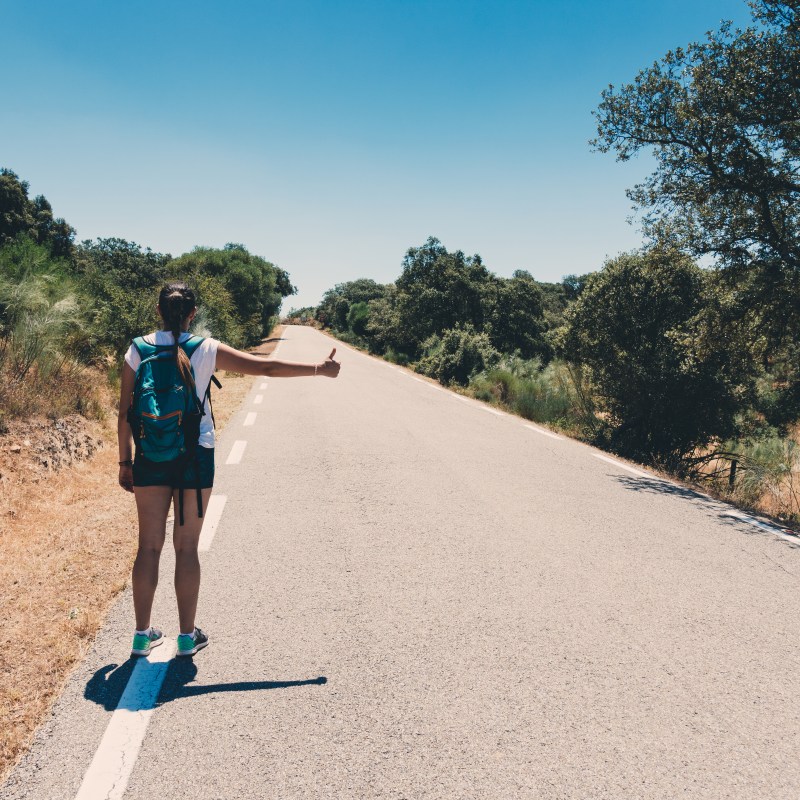
Hitchhiking—the unsung hero of casual transportation.
Videos by TravelAwaits
Or possibly a one-way ticket to ending up on a true crime headline, depending on whether you’re a pessimist or an optimist.
There’s no easy answer.
The only place I’ve ever consistently used hitchhiking for transportation was in Byron Bay, Australia. That’s the same country that produced Ivan Milat, a serial killer with the moniker ‘backpacker killer’ thanks to his penchant for disappearing hitchhikers around the Belanglo State Forest area.
That should clue you in: hitchhiking is a charged topic to dig into.
Though the vast majority of hitchhikers make it to their destination safely (and sometimes with a new friend in their Rolodex), the stories that go wrong tend to go way wrong.
And no matter how many success stories you hear, it’s hard to shake that fear—especially for Americans, as we tend to get spooked easily.
Regardless of your perception of hitchhiking, it’s still legal in many places around the world. And it’s still a reliable form of transportation for thousands of travelers, from backpackers with a thirst for open horizons to road trippers stranded roadside with broken down cars.
Can tourists still hitchhike? Yes—but I’d advise doing it with safety in mind. Here’s your crash course.
Hitchhiking is more common than you might think
When I did a semester of college in Byron Bay, our student housing was located just outside of town. We had bicycles that we could ride in to attend class or, as our professors insisted, we could hitchhike.
Though I never hitchhiked that short distance alone, I would have felt comfortable getting into each car that offered me a ride even if I were solo.
Not only were the drivers friendly, but they seemed sensitive to the fact that we, as hitchhikers, were taking a risk getting into their car. This was ten years ago, but I remember a few mentions of how often they offered rides to other hitchhikers, showing interest in our studies, and giving us a few recommendations around the area.
Globally, hitchhiking is more common than you might think—but it’s usually a regional habit. For example, Europe still has a solid hitchhiking culture, but you’ll notice that it’s even more prevalent in German-speaking areas like Germany, Belgium, and Austria.
Similarly, hitchhiking might have different norms depending on the region. For example, in Latin America and South America, hitchhiking is fairly common, but you’ll likely be asked to contribute a small amount to the journey. The same goes for South Asia, where hitchhiking is extremely common; you’ll likely be asked to contribute a small amount to the journey.
Places where you can hitchhike safely
- North America
- South America
- Europe
- South Asia
- New Zealand & Australia
Safety topics for hitchhikers
Many hitchhikers recommend working in pairs instead of going solo, especially for women. They also recommend carrying a can of pepper spray, avoiding sleeping while you’re hitching a ride, and not hitching a ride at night.
There are also two situations women need to be aware of. (Men should also have these concepts on their radar, too.)
The first is if you decide to hitchhike in a parking lot. In places like North America, some women solicit sex work in parking lots, especially at gas stations where big rigs stop. For obvious reasons, you don’t want to get mixed up in these situations.
Second, women hitchhiking in more conservative areas, in places like South Asia, in places like India and Sri Lanka, need to be aware of how solo female hitchhikers are seen.
Once again, you might get mixed up with someone looking for a sexual encounter. That might sound crazy, but I can tell you firsthand from my time in India that Western women are often viewed as open to and interested in sex thanks to popular music and movies. It’s a very difficult misconception to navigate, and that’s putting it lightly.
Men should also be wary, of course. Lone backpackers and hitchhikers are seen as easy targets, especially if they look like they might have expensive equipment with them. Importantly, men are less likely to report these incidents, which means some Bad Eggs will actually target men over women.
How to hitchhike like a pro

Assuming I haven’t turned you off from hitchhiking, here’s how you can set yourself up for success anytime you stick out your thumb.
- Before you hitchhike, check local laws. Though it might be legal in the country, many regions, states, and provinces have separate rulings. If you’re still not sure after doing some research, ask a local.
- Clear up whether the driver expects payment. Usually, the best time to do this is when you’re talking about the journey—which should take place before you get into the car.
- Speaking of destinations, write down where you’re going on a piece of cardboard/make a sign. That lets drivers know right off the bat whether they should bother stopping.
- If you don’t have your destination written down for all to see, go with a smile and try to make eye contact. You want to come off as friendly and unproblematic, without looking like a naïve dunce, of course.
- Know where to hitch a ride and where not to hitch a ride. The side of the highway is usually a bad spot, but entry ramps are good. As are gas stations, parking lots, tourist sites, campsites, and exit routes out of large cities.
- Know which gestures to make. A thumbs up works in North America, Europe, and Southeast Asia. In Australia and New Zealand, point to the road with your finger—but don’t do that in Asia, it’s rude. In South America, point your thumb horizontally instead of up.
